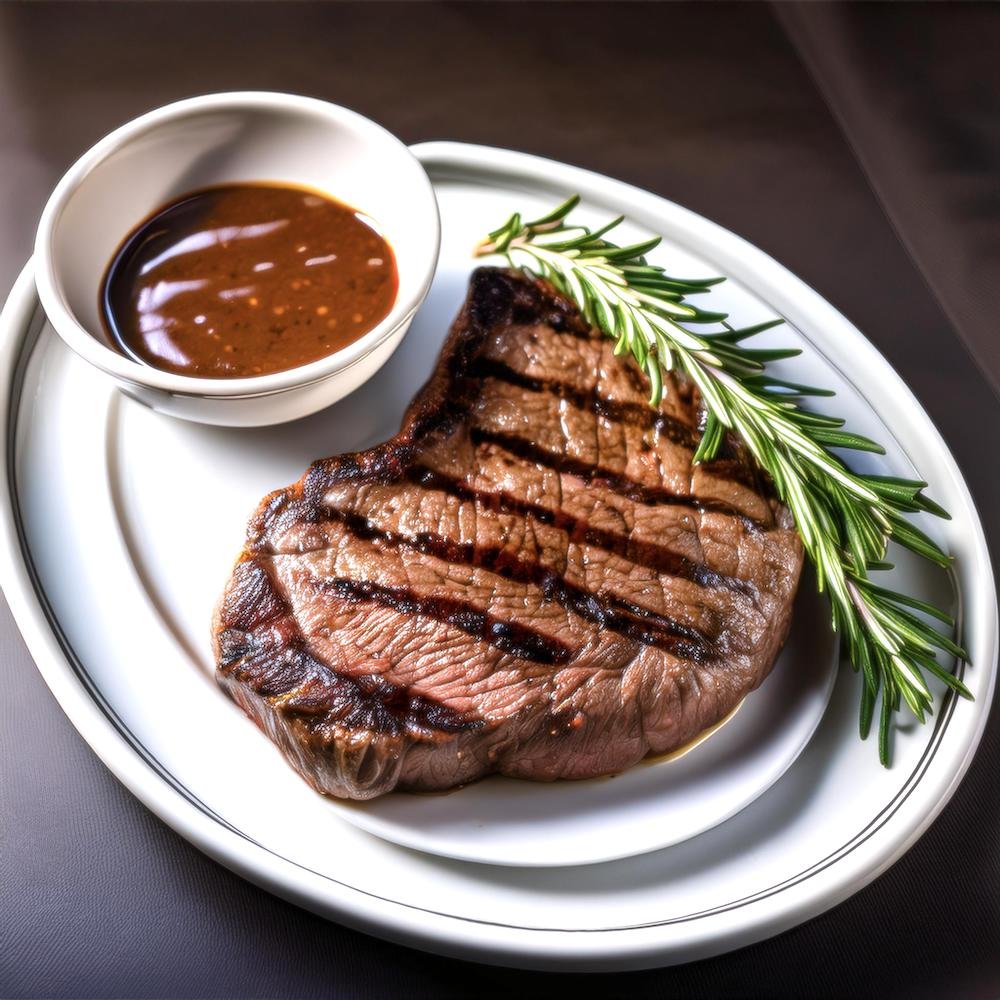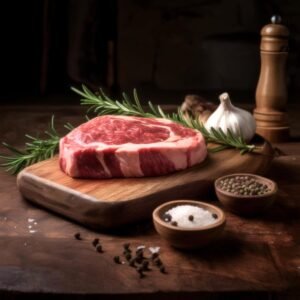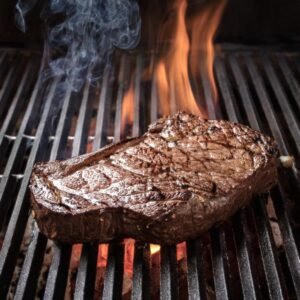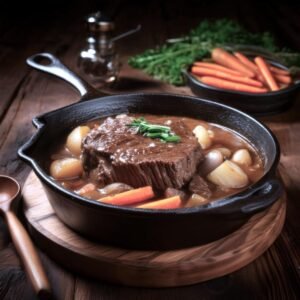What Is Beef Chuck Eye Steak Good For? Beef chuck eye steak is a hidden gem in the world of steak cuts. Known as the “poor man’s ribeye,” this cut offers the rich, beefy flavor of a ribeye steak but at a fraction of the cost. Cut from the shoulder primal, it’s located close to the rib section, giving it a flavor and marbling profile that makes it ideal for a variety of cooking methods.
Whether you’re grilling, pan-searing, or braising, chuck eye steak delivers exceptional taste and tenderness when prepared correctly. Its affordability and versatility make it a favorite among budget-conscious home cooks and steak enthusiasts alike.
In this article, we’ll explore what makes chuck eye steak special, how to use it in your cooking, and why it’s a fantastic choice for flavorful, hearty meals.
What Is Chuck Eye Steak?
Chuck eye steak is a cut of beef taken from the shoulder (or chuck) primal, specifically from the area near the ribs. It’s often compared to the ribeye because it shares a similar texture and marbling, but it’s generally more affordable.
Where It Comes From
- Location on the Cow:
- Chuck eye steak is cut from the 5th rib of the cow, right next to where ribeye steaks are sourced (6th to 12th ribs).
- This proximity gives it a similar flavor profile to ribeye but with slightly more connective tissue.
- Nicknamed the Poor Man’s Ribeye:
- Chuck eye steak is called this because it offers a comparable taste and tenderness to ribeye without the high price tag.
How It Differs from Other Cuts
- Chuck Eye vs. Ribeye:
- Ribeye is slightly more tender and consistent in marbling.
- Chuck eye has a slightly chewier texture but retains much of the same beefy flavor.
- Chuck Eye vs. Chuck Steak:
- Chuck steak is cut from the shoulder, further from the ribs, making it less tender and more suitable for slow cooking.
- Chuck eye is closer to the rib section and better for grilling or pan-searing.
Flavor Profile and Texture
Beef chuck eye steak is celebrated for its robust flavor and satisfying texture. While not as universally tender as ribeye, it still delivers a steakhouse-quality experience when prepared correctly.
Rich, Beefy Flavor
- Bold and Savory:
- Chuck eye steak has a deep, beef-forward flavor that’s enhanced by its marbling.
- The fat content adds richness, making it ideal for steak lovers who crave bold taste.
- Comparable to Ribeye:
- Its location near the rib primal gives it a flavor profile reminiscent of ribeye steaks.
- When cooked properly, it develops a caramelized crust that intensifies its savory notes.
Pro Tip: Season chuck eye steak simply with salt, pepper, and garlic to let its natural flavors shine.
Texture and Marbling
- Good Marbling:
- Chuck eye steak has streaks of intramuscular fat (marbling) that melt during cooking, keeping the meat juicy and tender.
- Tender with a Slight Chew:
- While not as melt-in-your-mouth tender as ribeye, chuck eye has a pleasant chewiness that’s satisfying without being tough.
- Slightly More Connective Tissue:
- Due to its proximity to the shoulder, it may have small amounts of connective tissue. Proper cooking techniques, such as resting the meat after cooking, help to mitigate this.
Pro Tip: For maximum tenderness, slice the steak against the grain when serving.
Uses of Chuck Eye Steak
Chuck eye steak is a versatile cut that works well in various recipes, from classic grilling to slow-cooked dishes. Its rich flavor and balanced marbling make it a go-to option for hearty, satisfying meals.
1. Grilling for a Steakhouse Experience
- Why It Works:
- The marbling in chuck eye steak ensures it stays juicy and flavorful on the grill.
- High-heat grilling creates a caramelized crust that complements its beefy flavor.
- Tips for Grilling:
- Preheat the grill to high heat and season the steak generously with salt, pepper, and garlic powder.
- Grill for 4–5 minutes per side for medium-rare, or adjust based on your preferred doneness.
- Let the steak rest for 5–10 minutes before slicing to retain its juices.
Best Pairings: Serve with grilled vegetables, baked potatoes, or a chimichurri sauce.
2. Pan-Searing for Quick Meals
- Why It Works:
- Pan-searing delivers a golden-brown crust and locks in the steak’s natural juices.
- It’s a fast and convenient method for weeknight dinners.
- Tips for Pan-Searing:
- Use a cast-iron skillet for even heat distribution.
- Heat the pan until it’s smoking hot, then add a high-smoke-point oil like avocado or vegetable oil.
- Sear each side for 3–4 minutes, then finish in the oven if needed for thicker cuts.
Best Pairings: Pair with mashed potatoes, sautéed spinach, or a red wine reduction sauce.
3. Braising for Tenderness
- Why It Works:
- The slightly tougher texture of chuck eye steak benefits from slow-cooking methods like braising, which breaks down connective tissue.
- This method is perfect for creating tender, fall-apart meat.
- Tips for Braising:
- Sear the steak on both sides to build flavor, then simmer it in a flavorful liquid such as beef broth, wine, or tomato sauce.
- Cook low and slow for 2–3 hours in the oven or on the stovetop.
Best Pairings: Serve with polenta, roasted root vegetables, or crusty bread to soak up the sauce.
4. Stir-Frying or Slicing for Recipes
- Why It Works:
- When thinly sliced against the grain, chuck eye steak becomes tender enough for stir-fry dishes, fajitas, or steak sandwiches.
- Tips for Slicing:
- Freeze the steak for 15 minutes before slicing to make it easier to cut thinly.
- Marinate slices in soy sauce, garlic, and ginger for extra flavor before stir-frying.
Best Pairings: Use in Asian-inspired stir-fries, tacos, or Philly cheesesteaks.
How to Cook Chuck Eye Steak
Cooking chuck eye steak properly is key to bringing out its best flavor and texture. Whether you’re grilling, pan-searing, or roasting, these methods ensure a delicious and tender result.
Grilling Chuck Eye Steak
- Preparation:
- Remove the steak from the fridge and let it come to room temperature for 30 minutes.
- Pat it dry with paper towels and season generously with salt, pepper, and garlic powder.
- Grilling Steps:
- Preheat your grill to high heat (450°F–500°F).
- Place the steak on the grill and sear for 4–5 minutes per side for medium-rare. Use a meat thermometer to check doneness (135°F for medium-rare).
- Let the steak rest for 5–10 minutes after grilling to allow the juices to redistribute.
Pro Tip: Add a pat of compound butter (butter mixed with herbs or garlic) on top of the steak while it rests for added flavor.
Pan-Searing Chuck Eye Steak
- Preparation:
- Season the steak with salt, pepper, and any preferred spices. For extra flavor, rub it with olive oil and fresh rosemary or thyme.
- Pan-Searing Steps:
- Heat a cast-iron skillet over medium-high heat and add a tablespoon of high-smoke-point oil (e.g., avocado oil).
- Place the steak in the skillet and sear for 3–4 minutes on each side. For thicker steaks, finish cooking in a preheated oven at 375°F until the internal temperature reaches your desired doneness.
- Rest the steak for 5–10 minutes before slicing.
Pro Tip: Baste the steak with melted butter during the last minute of searing for a richer flavor.
Braising Chuck Eye Steak
- Preparation:
- Season the steak with salt and pepper, then sear it in a hot skillet to develop a crust.
- Remove the steak and set aside while you prepare the braising liquid.
- Braising Steps:
- In the same skillet, sauté onions, garlic, and carrots, then deglaze with red wine or beef broth.
- Return the steak to the skillet and add enough liquid to cover it halfway.
- Cover and simmer on low heat or bake in the oven at 300°F for 2–3 hours until tender.
Pro Tip: Add fresh herbs like thyme or rosemary to the braising liquid for enhanced flavor.
Roasting Chuck Eye Steak
- Preparation:
- Marinate the steak for 2–4 hours in a mixture of olive oil, soy sauce, garlic, and lemon juice to tenderize and flavor the meat.
- Roasting Steps:
- Preheat the oven to 400°F and place the steak on a wire rack over a baking sheet.
- Roast for 10–15 minutes, flipping halfway through, until it reaches the desired internal temperature.
Pro Tip: Use the broiler for the last 2 minutes of cooking to develop a caramelized crust.
General Cooking Tips for Chuck Eye Steak
- Resting is Essential:
- After cooking, always let the steak rest to retain its juices and ensure tender, flavorful meat.
- Slice Against the Grain:
- For optimal tenderness, slice the steak against the grain before serving.
- Use a Meat Thermometer:
- Ensure the steak is cooked to the perfect doneness:
- Rare: 125°F
- Medium-Rare: 135°F
- Medium: 145°F
- Ensure the steak is cooked to the perfect doneness:
Benefits of Chuck Eye Steak
Chuck eye steak is often overlooked in favor of more expensive cuts like ribeye or filet mignon, but it offers a range of benefits that make it a standout choice for steak lovers. Here’s why chuck eye steak deserves a place in your kitchen.
1. Affordable Alternative to Ribeye
- Cost-Effective:
- Chuck eye steak is significantly cheaper than ribeye, making it an excellent option for those seeking a high-quality steak on a budget.
- Despite the lower price, it retains much of the flavor and marbling that steak enthusiasts love.
- Availability:
- Found in most grocery stores and butcher shops, chuck eye steak is accessible without the premium price tag of more well-known cuts.
Pro Tip: Look for chuck eye steak labeled as “Delmonico steak” or “mock ribeye” for an upgraded dining experience without breaking the bank.
2. High Fat Marbling for Flavor
- Rich and Juicy:
- The marbling in chuck eye steak ensures a flavorful and juicy bite, similar to ribeye.
- This natural fat content makes the steak tender and adds depth to its beefy flavor profile.
- Versatility in Cooking:
- The marbling helps the steak remain moist whether you grill, pan-sear, or braise it, making it forgiving even for novice cooks.
Pro Tip: To maximize flavor, use high heat to sear the steak and lock in the juices.
3. Versatility in Recipes
- Adaptable for Multiple Cooking Methods:
- Chuck eye steak performs well across a variety of cooking methods, from quick grilling to slow braising.
- It can be used in classic steak recipes or incorporated into stir-fries, tacos, and more.
- Customizable Flavor:
- Takes well to marinades, spice rubs, and sauces, allowing you to tailor the steak’s flavor to your preferences.
Pro Tip: Marinate chuck eye steak for at least 2 hours before cooking to enhance its tenderness and infuse it with flavor.
4. Perfect for Weeknight or Special Meals
- Quick-Cooking for Busy Nights:
- Chuck eye steak is easy to cook, making it ideal for weeknight meals that don’t sacrifice flavor.
- Impressive Presentation:
- With proper cooking, it delivers a steakhouse-quality experience that’s perfect for entertaining guests or celebrating special occasions.
Pro Tip: Pair with roasted vegetables and a glass of red wine for a restaurant-style meal at home.
5. Nutritional Benefits
- Protein-Packed:
- Chuck eye steak is an excellent source of protein, supporting muscle repair and growth.
- Rich in Vitamins and Minerals:
- High in iron, zinc, and B vitamins, chuck eye steak contributes to a balanced and nutrient-rich diet.
Pro Tip: Pair with leafy greens or a baked sweet potato for a well-rounded, nutritious meal.
FAQs About What Is Beef Chuck Eye Steak Good For?:
What Do You Use Chuck Eye Steak For?
Versatile Cooking Options: Chuck eye steak is perfect for grilling, pan-searing, braising, and even stir-frying.
It can be used in recipes like steak fajitas, steak sandwiches, or classic steak dinners.
Budget-Friendly Substitute: It’s an affordable alternative to ribeye for recipes that require a rich, beefy flavor.
Pro Tip: Thinly slice chuck eye steak against the grain to use it in stir-fries or tacos for tender, flavorful bites.
Is Chuck Eye Steak as Good as Ribeye?
Flavor Similarity: Chuck eye steak is often called the “poor man’s ribeye” because it shares a similar marbling and rich beefy flavor.
Tenderness Comparison: While ribeye is slightly more tender due to its location on the cow, chuck eye steak is still tender enough for grilling or searing when cooked properly.
Pro Tip: Let the steak rest after cooking to maximize tenderness and flavor.
What Is Chuck Steak Best For?
Slow-Cooking Dishes: Chuck steak (distinct from chuck eye steak) is best for slow-cooked recipes like pot roast, beef stew, or braised dishes due to its tougher texture.
Braising and Roasting: The connective tissue in chuck steak breaks down during slow cooking, resulting in tender, flavorful meat.
Pro Tip: Marinate chuck steak before grilling or roasting to enhance flavor and tenderness if using it for quicker cooking methods.
Are Chuck Eye Steaks Good for Grilling?
Absolutely: Chuck eye steaks are excellent for grilling, thanks to their marbling, which keeps the meat juicy and flavorful.
Grilling Tips: Use high heat to sear the steak, and grill for 4–5 minutes per side for medium-rare.
Rest the steak for 5–10 minutes after grilling for the best texture.
Pro Tip: Add a spice rub or a simple seasoning of salt and pepper to enhance the natural beefy flavor before grilling.
Suggested Internal Links for:
- Beef Chuck Eye Steak
Dive deeper into the characteristics and cooking methods for chuck eye steak. - How to Make the Viral Crookie?
Pair your steak dinner with a fun and sweet dessert like the viral crookie. - How Is Chuck Steak Best Cooked?
Explore versatile cooking techniques to enhance chuck steak’s flavor and texture. - What’s the Best Way to Cook Chuck Eye?
Discover step-by-step methods for preparing chuck eye steak to perfection. - Is Chuck Eye Steak the Same as Ribeye?
Compare chuck eye steak to ribeye and learn why it’s often referred to as the “poor man’s ribeye.”
Conclusion About What Is Beef Chuck Eye Steak Good For?
Beef chuck eye steak is a versatile and flavorful cut that stands out as a budget-friendly alternative to more expensive steaks like ribeye. With its rich marbling, bold flavor, and adaptability to various cooking methods, it’s an excellent choice for grilling, pan-searing, braising, or incorporating into hearty recipes like stir-fries and tacos.
While chuck eye steak may not be as tender as ribeye, its affordability and comparable taste make it a favorite among home cooks and steak enthusiasts. Proper preparation, such as seasoning well, cooking to the right doneness, and letting it rest, ensures a tender, juicy steak every time.
Whether you’re hosting a special dinner or preparing a quick weeknight meal, chuck eye steak delivers exceptional value and flavor. It’s time to elevate your steak game with this underrated yet delicious cut of beef.
Discover more mouthwatering recipes on our Web Site ! Stay connected and get inspired by following us on Facebook, Instagram, Pinterest, and Twitter for the latest updates!




